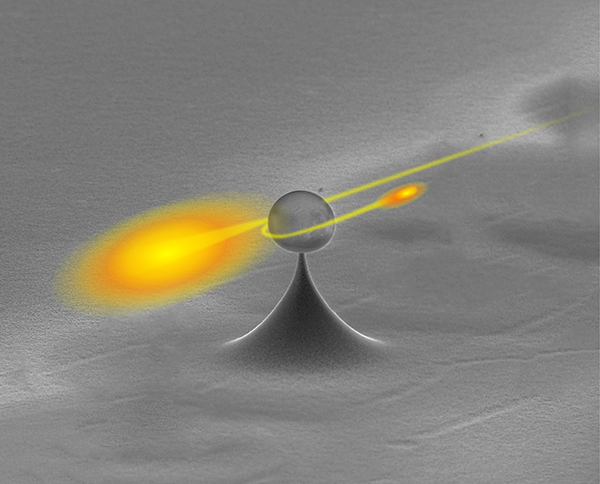Capturing a single photon
November 30, 2015

Capturing a single photon from a pulse of light (credit: Weizmann Institute of Science)
Weizmann Institute of Science researchers have managed to isolate a single photon out of a pulse of light. Single photons may be the backbone of future quantum communication systems, the researchers say.
The mechanism relies on a physical effect that they call “single-photon Raman interaction” (SPRINT). “The advantage of SPRINT is that it is completely passive; it does not require any control fields — just the interaction between the atom and the optical pulse,” said Barak Dayan, PhD, head of the Weizmann Institute Quantum Optics group.
The experimental setup involves laser cooling and trapping of atoms (in this case, rubidium), optical nanofibers, and fabrication of chip-based, ultrahigh-quality glass microspheres.
Previously, a low-reflectivity beam splitter directing a small fraction of the incoming light toward a detector was used, with low success rates.
“The ability to divert a single photon from a flow could be harnessed for various tasks, from creating nonclassical states of light that are useful for basic scientific research, through eavesdropping on imperfect quantum-cryptography systems that rely on single photons, to increasing the security of your own quantum-communication systems,” Dayan said.
The findings of this research appeared Nov. 23, 2015 in Nature Photonics.
Abstract of Extraction of a single photon from an optical pulse
Removing a single photon from a pulse is one of the most elementary operations that can be performed on light, having both fundamental significance and practical applications in quantum communication and computation. So far, photon subtraction, in which the removed photon is detected and therefore irreversibly lost, has been implemented in a probabilistic manner with inherently low success rates using low-reflectivity beam splitters. Here we demonstrate a scheme for the deterministic extraction of a single photon from an incoming pulse. The removed photon is diverted to a different mode, enabling its use for other purposes, such as a photon number-splitting attack on quantum key distribution protocols. Our implementation makes use of single-photon Raman interaction (SPRINT) with a single atom near a nanofibre-coupled microresonator. The single-photon extraction probability in our current realization is limited mostly by linear loss, yet probabilities close to unity should be attainable with realistic experimental parameters.